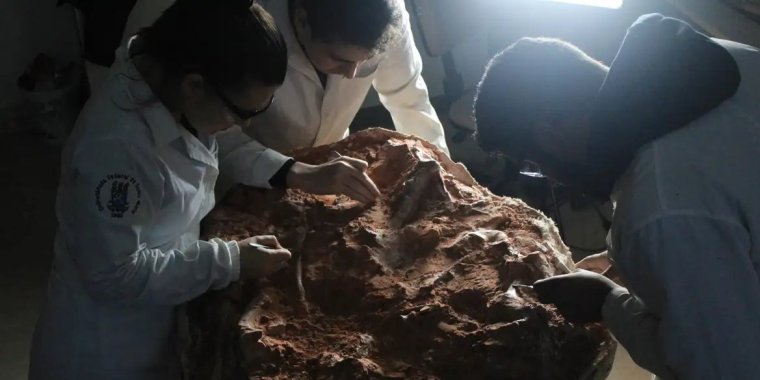| News / Science News |
Fossil found in Brazil should cast light on the origin of dinosaurs
Researchers from the Paleontological Research Support Center of Quarta Colônia (Cappa), at the Federal University of Santa Maria (UFSM), in Rio Grande do Sul state, have made a momentous discovery for world paleontology in the municipality of São João do Polêsine, in the central region of the state.

Fossil found in Brazil should cast light on the origin of dinosaurs. Photo: Rodrigo Temp Müller
In May, after heavy rains brought floods and destruction to South Brazil, specialists found an almost complete fossil of a dinosaur from the Herrerasauridae group, which lived in the Triassic Period, estimated to be 233 million years old.
“It’s among the oldest in the world. It’s already important because of the role it’s likely to play in helping us understand the origin of the dinosaurs. Besides, it’s almost fully preserved.
The material will provide a lot of anatomical information,” UFSM paleontologist Rodrigo Müller told.
“It’s a carnivorous, bipedal animal, so it walked on its hind legs and probably had its hands free to handle prey. We can’t say it had reached its maximum size. Although he was 2.5m long, some individuals in this group could reach five or six meters. Perhaps it could have grown more if it had lived longer,” he stated.
The animal should be incorporated into the collection of Cappa, which, the researcher added, is one of the most important centers in the world for studying how dinosaurs originated.
“Here we have the world’s main specimens. This material will come as a great addition and help us understand these early dinosaurs. It’s interesting that it’s a predatory dinosaur. It brings new data from this first wave of dinosaurs that occupied the top of the food chain at the time of the origin of the dinosaurs,” he noted.
Müller led the Cappa team that searched the São João do Polêsine site. “It was already a paleontological site. There has been work there for at least two decades, but the rains sped up the erosion and uncovered more material,” he said.
The rains in May, which wreaked havoc in the state, helped bring the material to light. Now the researchers are rushing to avoid missing out on other potential discoveries.
“The rain helps us all year round, as it exposes the fossils through natural erosion. However, when rainfall is high, as was the case this time, the material exposed ends up being destroyed, sometimes during the event itself. If there’s a lot of rain, small materials are sometimes lost before we can get to them, so now we are rushing to rescue all the materials that have been uncovered,” he stated.
The region where the fossil was spotted includes sections of nine municipalities and is part of the Quarta Colônia Geopark.
The area is said to be rich in paleontological material, with outcrops of Triassic rocks, and abundant in fossils of vertebrates, invertebrates, and plants, as well as trace fossils. (Cristina Indio do Brasil/Agência Brasil)
YOU MAY ALSO LIKE





